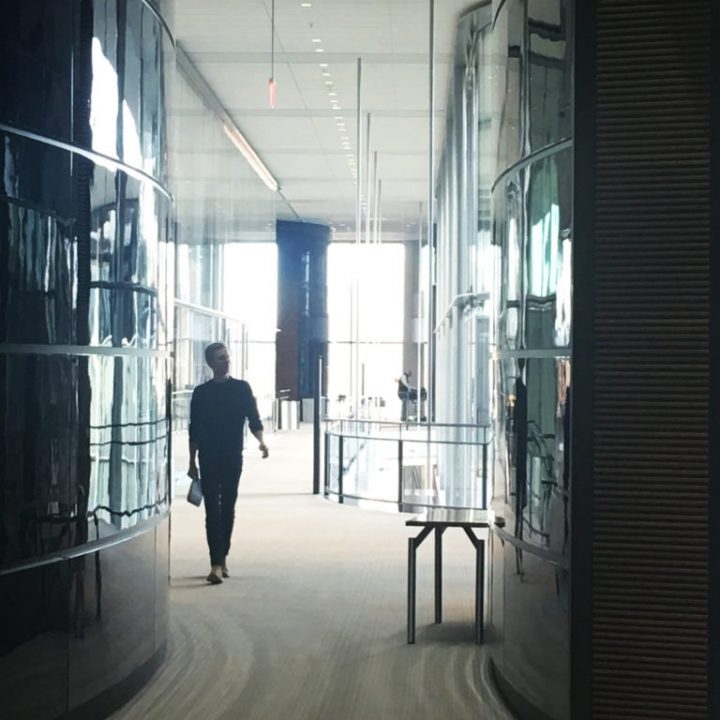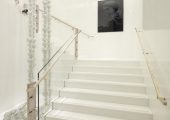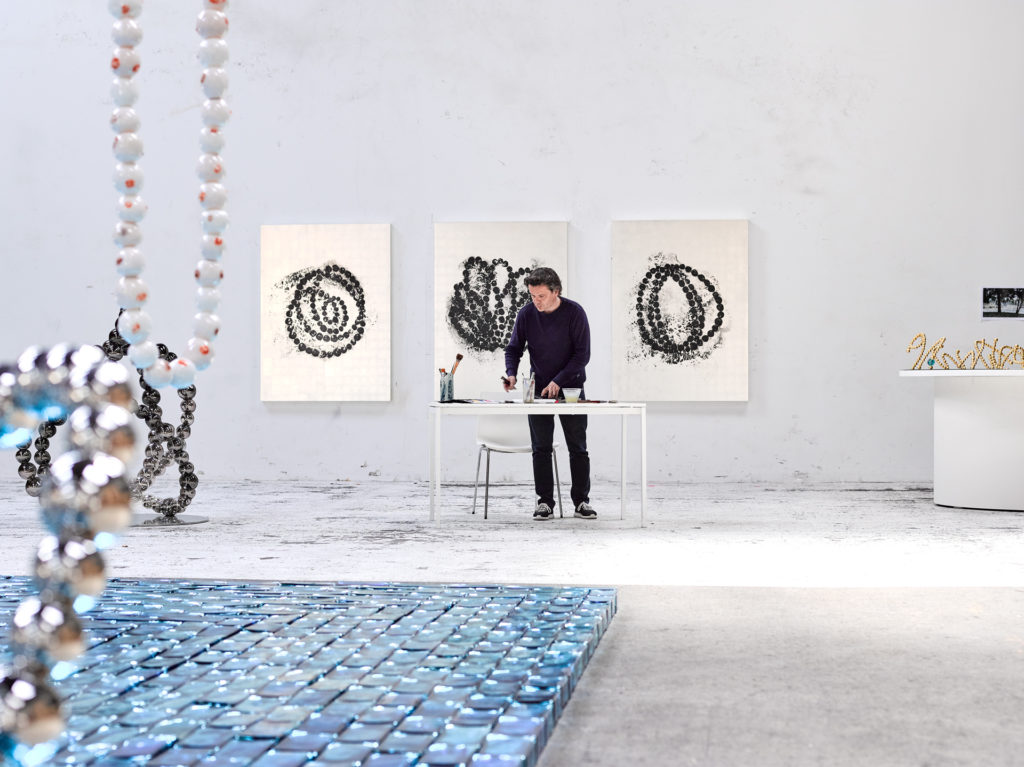Since the late 1980s Jean-Michel Othoniel has been performing in different art of a multi-faceted world. After exploring the possibilities of some materials, such as sulphur and wax, in 1993 he started work and experiments with glass. His first works as a giant glass necklaces, were exhibited in the Roman gardens, before installing them in the Venetian gardens of the Guggenheim Foundation in Venice, and then at the Alhambra in Granada.
Today his works take on an architectural dimension, occupying historic sites and magnificent gardens, like at the Château de Versailles and the Palais Royal-Musée du Louvre metro station in Paris, through both public and private commissions around the world.
His successful and breathtaking creatures of glass got an attention from bigger brands, Houses, such as CHANEL, and after commissioning pieces for various boutiques, the House has given him a fresh field of new expression: the new boutique in New York on 57th Street which was opened yesterday (on 15th November).
The pearl is an emblematic code at the House of CHANEL. Is it one for you too? Where does your interest in this element come from?
I started really making works that featured pearl-shapes in 1997 at the Guggenheim in Venice. It was my first exhibition and I was looking for a symbolic element in relation to the body. I imagined a giant pearl, completely oversized, that resembled fragments of the body, reminiscent of the breasts, of curves that can be caressed. These pearls took on a baroque, irregular form. Some bore the mark of the glass blower, the imprint of his hand, sometimes even his scars. Details that were all relevant to my work. I’m part of a generation of artists from the 90s, that’s very preoccupied with issues relating to the body.
And through the pearl, comes the necklace…
The shape of the pearl necklace has become important because it allows me to compose large scale works, which is unexpected when using glass. It’s a very personal language that today has become my signature. To make these “necklace pieces” I have been collaborating with Murano glassmakers since 1997. It was the first time I worked with artisans and it was a turning point in my work. I then began to weave a network of glass blowers, embroiderers, smelters, metal-workers and other artisans who today are an integral part of my working process. At my atelier in Paris, there are 14 of us, but we often work hand-in-hand with glassmakers in Italy, Switzerland, India, as well as metal workers forging in several European countries. It is a major engineering collaboration, especially for the large-scale works which ultimately are very close to architecture.
It was Peter Marino who suggested that you work with CHANEL. How did you meet?
The architect Peter Marino discovered my work in Paris in 2004. He saw things in my work I’d never even imagined, in particular the possible connection with the Luxury domain, a domain I wasn’t at all familiar with back then. He also saw an echo with Gabrielle Chanel’s necklaces, exaggerated and extravagant in the materials that she wore. The question came about on its own: how do we reinvent this pearl in a sculptural way in a world outside that of contemporary art. My first creation for CHANEL dates back to 2007. It’s in the Hong Kong boutique, where Peter Marino gave me carte blanche to work in a given space: the staircase. The necklace imposed itself quite naturally, transforming into the backbone of the architecture. It’s as if we’re climbing up this necklace, which in turn creates a link between the three floors of the boutique.
But isn’t it frustrating for an artist to work in a boutique, a space that is by essence commercial?
No, not here. With CHANEL and Peter Marino there’s always a special space devoted to contemporary art in the boutiques. And it’s an open space for expression, where the works unfold in complete freedom, and where anyone can get up close without having to pay an entrance fee, sometimes you can even see them from the street, it’s incredible! While they have to echo the CHANEL aesthetic and colours, our collaboration always respects this rule of the game. It’s a real pleasure playing with these spaces because each time they offer the challenge of dialoguing with the architecture and experimenting with prototypes, shapes and materials. In this sense, CHANEL takes on the role of a patron, allowing me to evolve within my own work. And it’s an amazing opportunity for an artist to work with such an architect and such a house. CHANEL sends out a very French image of my work, it allows me to see how the different cultures react to my works. It’s very rare that an artist is able see how their work is perceived internationally, especially when it’s immersed for several years in a variety of countries and cultures.
You talk of experimenting through your collaborations with Peter Marino and CHANEL. Can you give us an example?
I think the notion of scale is probably the best example. Peter is an architect, so for him, this is essential. When we first met, I was creating works that were 2 or 3 meters high. With him they became 7 or 8 meters high, which was already exceptional. And then we went even further with an 11-meter-high piece for the CHANEL boutique in London. In New York, we’ve reached 17 meters. These are major technical feats. To achieve them, I work with an engineer on the distortion of materials, organising specific pre-assemblies. The work arrives in the boutique at the very last minute – it’s a new challenge each time – you must be able to dismantle it in response to the architectural context. Often, you’re squeezing a monumental sculpture through a tiny door. These technical interrogations are fascinating for an artist, they engender a relationship and a dialogue with the architecture that is truly unique.
Your new work for CHANEL promises to be monumental. Can you tell us about it?
Firstly, the boutique is vast. Four floors and impressively high ceilings… it’s the ultimate American building. So, we had to imagine a piece in relation to this scale and come up with a game between the use and the scenography of the boutique, playing with the notion of American supersize, introducing a truly vertiginous dimension of verticality. I thought of two enormous glass beaded necklaces that form big bows in the space and thus fill the stair case. Positioned at the centre of the building, the work is composed of a hundred spheres blown by hand, then rolled in white gold leaf and mirrored to double the presence of this leaf. Ranging in sizes, some of them are as big as 18 cm in diameter. They reflect the architecture of the boutiques as much as the physical presence of the visitors. The latter seems to be absorbed and infinitely diffracted by the beads and their material. For this monumental work, the drawings had to be very technical, we had to carry out major research into the materials and their distortion, develop specific engineering techniques, work closely with the architect and the building technicians, and think of a structure that brings and shows all of that on 57th Street. I learnt a lot. The preparation alone took a year and a half.
You’re at the heart of this dialogue between art and fashion. What do you think of the relationship between these two worlds today?
For me, it’s a tradition that’s come to us from Asia. Thirty years ago, when I was exhibiting in Japan, showing art in fashion spaces was already the norm, because there wasn’t really a culture of contemporary museums there. Artists seemed to naturally collaborate with brands. We’ve realised that in China today, people come into the boutiques as if they were going to a museum: as though it’s part of a tour where they admire the clothes as much as the works of art. This Asian vision has, I believe, influenced all countries and France is perhaps one of the last to accept how meaningful this dialogue is to everyone today. It gives even greater resonance to my first work made for CHANEL for the boutique in Hong Kong, as the public there have huge respect for this space which for them has become a cultural destination. In this sense, New York is also unique. The boutique is surrounded by museums, it’s very near Madison Avenue. Today the visitors come not only from the world of fashion, but also from the world of art. This kind of visibility is an incredible opportunity.
I have made over 30 works for CHANEL around the world and for each flagship store I have had to renew myself, dialoguing differently with different architectures, evolving within the story told by a House that travels from one country to the next. I like the fact that we never repeat ourselves, each time we’re surprised all while recognising the signature of our collaboration. The idea of fun, of joy and of a renewed challenge is something I keep intact within me. The visitor should get the impression of being alone face to face with the work, that it exists only for them, that it is a gift.












No Comment